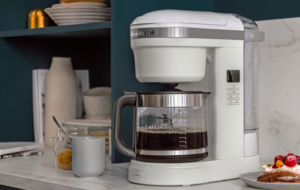
If you like coffee, you’ve probably experimented with every form of coffee maker—the single-cup Keurig, a French press, a Moka pot, and even a grinder for fresh grounds. If you’re like most coffee drinkers, you’ve reverted to the original coffee pot since it makes enough coffee for a tableful of drinkers and swiftly creates another pot for seconds.
Most traditional coffee makers function by pumping hot water through a filtered basket of coffee grounds into a glass carafe. These makers are efficient, frequently have a warming plate, and are simple to operate. They must also be cleaned on a regular basis to eliminate minerals that adhere to the maker from the water used, as well as coffee oils that stick to the components, get rancid, and degrade the coffee taste.
After each use, clean the coffee maker by draining the grinds and washing the removable components, including the glass or metal pot, with hot, soapy water.
A deeper cleaning should be performed at least every other month—monthly if you live in a section of the country that has hard water—to eliminate the build-up of oils and any mineral residue left by the water. Cleaning a classic coffee maker, whether metal or glass, is simple and requires only a few tools to produce a better-tasting cup of coffee.
Hard water stains are white mineral deposits that form on surfaces and the interiors of water-using small appliances. Hard water stains are especially common in households that use well water in locations with high quantities of minerals like lime and calcium in groundwater. It’s always best to read the manufacturer’s user guide before cleaning any small appliance. Some components may be dishwasher safe but unless you know for sure, hand wash each part to prevent damage.
Here is how to deep clean the coffee pot:
- Unplug the pot – Always make sure you unplug the pot and let it cool down before disassembling it and attempting to clean it.
- Put the coffee grinds and any discarded filters in the trash can or compost bin. There are various ways to repurpose leftover coffee grounds around the house and garden, but never put them down the sink.
- Mix a cleaning solution – To make a soapy solution, combine hot water and dishwashing liquid in a dishpan or sink.
- Clean the inside of the pot – Remove the brew basket and, if applicable, the permanent filter. To remove oils and residue, thoroughly wash them in hot, soapy water with a sponge. Inside and out, clean the glass or metal coffee pot.
- Thoroughly rinse and dry – Rinse each component in hot water and dry with a lint-free microfiber towel. Reassemble the coffee maker.
To descale a coffee pot:
- Use vinegar – After emptying the grounds and any coffee in the carafe from the coffee maker. Fill at least three cups of distilled white vinegar into the water reservoir. If you’re going to use cleaning vinegar, dilute it with water: two cups vinegar to one cup water.
- Allow the vinegar or vinegar and water solution to sit in the reservoir for at least one hour to aid in the dissolution of mineral deposits on the coffee maker. Then start a brewing cycle. Allow the vinegar to rest in the coffee maker for another hour after it has passed through the coffee maker. It is fine to leave the vinegar in the coffee pot overnight.
- After the vinegar has had time to do its job, pour it down the kitchen sink drain. Fill the coffee maker to the top of the reservoir with water (no coffee grounds) and run a full brewing cycle. Remove the water and repeat the rinse cycle.
- Wipe off the external surfaces of the coffee maker with a damp microfiber cloth to remove splatters and smudges. Your coffee machine is now operational.
Even though regular cleaning of your coffee pot is important, it may not always work as well as you would like to. Once the hard deposit builds up, it may become hard to remove. It is best if you take preventive measures and keep it from happening in the first place. Here are some tips on how to prevent hard water and mineral deposits from developing:
- To avoid mineral deposits, make coffee with distilled water.
- To eliminate oils and sediment, rinse and wash the coffee pot components after each use, preferably at least daily.
- Do not allow coffee to sit in the carafe all day, especially if it has a warming plate. The coffee will eventually evaporate, leaving a burned-on ring in the pot.
- Make sure you don’t leave coffee grounds in the filter for too long. They will be damp after the coffee is brewed and mould and mildew may grow in there. That may make your coffee taste musty, especially if you are using the permanent filter and not disposable ones.
